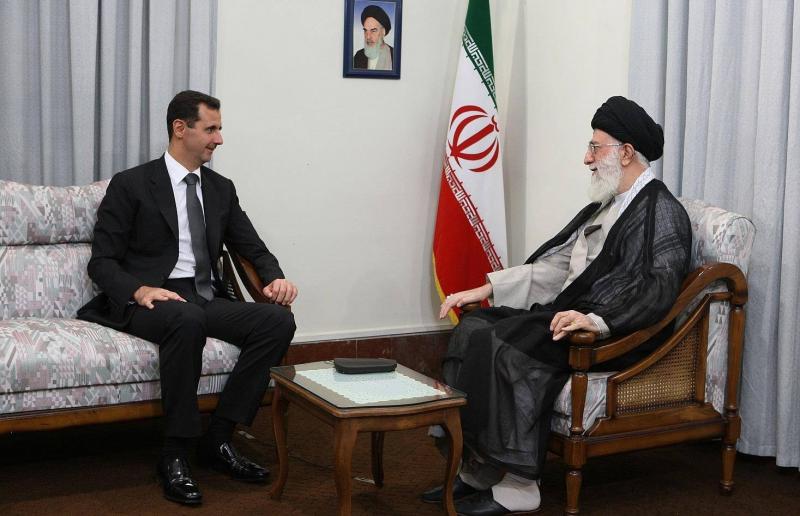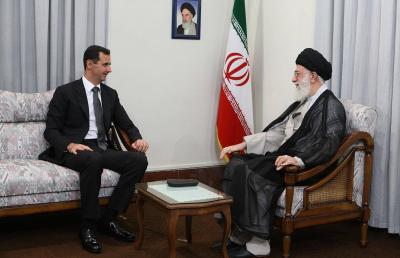The words spoken by Iranian Supreme Leader Ali Khamenei during his meeting with Syrian President Bashar al-Assad carry "messages and directives," and according to experts and observers, they paint a clear picture of the current and future relationship between the two "allies." Although Assad is Iran's "most prominent ally" in the region, he was one of the last to express condolences for the death of Iranian President Ebrahim Raisi in a helicopter crash on May 19, alongside seven others, including Iranian Foreign Minister Hossein Amir-Abdollahian.
Official media did not precisely publish the details of the meeting between Khamenei and Assad, contrasting with the official announcements from Khamenei's site and subsequent notable tweets on his official accounts on the social media platform "X." In one of his tweets, Khamenei accused "the West and its followers in the region of seeking to overthrow the political system in Syria and exclude it from regional equations by igniting war," noting that while they "did not succeed" in earlier attempts, similar efforts are being made now. He added, "Now they also aim to exclude Syria from regional equations through other means, including promises they will never fulfill."
While the Iranian supreme leader did not clarify what "regional role" Syria plays or what the "promises" entail, he emphasized in subsequent tweets the "identity of resistance that distinguishes Syria," which "must be preserved."
**War and Normalization**
The last visit by Assad to Iran was in May 2022, and he visited before that in 2019. Since 2022, numerous changes have occurred in the region, including Arab countries restoring relations with Assad's regime, marking a significant transformation from their previous policy when peaceful protests turned armed. The war in Gaza erupted in response to a Hamas attack on October 7, 2023, followed by several fronts igniting, although Syria did not become a battleground despite being a key player within the "Axis of Resistance."
The Syrian regime maintained a policy of "staying out of the conflict" regarding the ongoing war in Gaza, appearing "unconcerned with involvement" since the events of October 7, according to observers. Conversely, it displayed flexibility and navigated various details regarding the evolving path of Arab normalization, which currently encompasses both declared and undeclared approaches. This involves evaluating the nature of the relationship between Damascus and Tehran and the capability to achieve breakthroughs in their "entrenched partnership."
Khamenei reminded Assad that "Iran has a similar experience negotiating with the Americans, but they quickly violated the pact and agreements," referring to the nuclear agreement from which former U.S. President Donald Trump withdrew. He underscored that the "supreme leader's emphasis on Syria's identity as a resistance" was meant as a reminder to Assad that historically, Syria has aligned with what is termed the Axis of Resistance.
**A Hardline Approach**
During the meeting with Khamenei on Thursday, Assad conveyed to the Iranian supreme leader that "Syrian-Iranian relations are strategic and progressing under your esteemed guidance." However, Syrian state media did not mention this statement. The remarks published by the SANA news agency focused on expressing condolences and underscoring "the necessity of continuing to enhance bilateral relations in various fields, especially economic ones."
Despite Syria recently highlighting the idea of "Arab peace" as a potential "path towards a global solution," it has not taken any practical steps, which was later evident from the positions of some Arab nations, according to analyst Amer al-Sbaileh.
**Within the Iranian Sphere**
Tehran is one of the main allies of the Syrian regime, alongside Russia, having provided military, political, and economic support over the years. The nature of their relationship in light of ongoing Arab normalization remains unclear, recently illustrated by Saudi Arabia appointing an ambassador in Damascus and announcing its readiness to operate three direct flights to the Syrian government.
The outbreak of the Syrian war in 2011 provided Iran with an opportunity to increase its influence in Syria, driven by the country's strategic importance and its role in ensuring a land corridor from Tehran to Beirut, connecting to the Mediterranean Sea, as various reports by Western media and research centers indicate.
Statistics detailing Iran's expenditures in Syria are rarely published. Nonetheless, deputy Heshmatollah Falahat-Pisheh from the National Security and Foreign Policy Committee stated in a notable comment in 2020 that Iran has spent between 20 to 30 billion dollars supporting Bashar Assad.
Researcher Mounir al-Bazi highlights that "Assad realizes that while Western and Arab initiatives are significant, they come with a very high price, which involves conceding some sovereign powers." Therefore, "the historically rooted relationship with Iran is of utmost importance to him."
Al-Bazi adds that "Iran does not impose political changes or radical transformations on Assad that he does not desire... Therefore, it is not easy for him to easily abandon this relationship, especially since it falls within a strategic alliance." This alliance is based on history, common threats, and mutual benefits, all of which have not changed during this period.
Additionally, he clarifies that "Iran exerts multifaceted influence that extends beyond formal channels in Syria... it plays a role among tribes in eastern Syria, provides services in Aleppo, and also influences in the coastal region."
It is not easy for Assad to distance himself from Iran, as per Al-Sbaileh's analysis, and given the entrenched nature of the situation in the country, he "must reassure Tehran on one side while pursuing an Arab path on the other." Al-Sbaileh concludes that the Assad regime "knows that Iran cannot extricate Syria from isolation," and that it "is a persistent crisis in itself," which compels him to "find a state of diplomatic balance at the moment."




